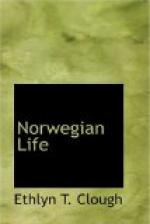Norway offers a fine field for reformers to study the effects of regulation upon the vice of drunkenness. Within the limits of the kingdom are all grades of restriction, from prohibition to liberal license. There are no pretensions about the Norwegians; there is no affectation about their morals and no leniency in the administration of their laws. The police and the magistrates are merciless and inexorable, and crime is punished more severely perhaps than in any other country. At the same time the people distinguish an important difference between temperance and total abstinence. They give their children beer in unlimited quantities, but absolutely prohibit the sale of whisky, and send drunken men to prison with burglars and assassins. Norwegian reformers hold that beer is the great promoter of temperance, and encourage its use as a beverage, although every saloon in the kingdom is closed on Sundays, on all holidays, and Saturday afternoon, which is the regular pay day for the working classes. These are practical regulations, devised for the purpose of restraining those who are not capable of controlling their own appetites and encouraging thrift and economy. While the saloons are closed on pay day, the savings banks are open until midnight.
It is difficult to become accustomed to the long twilights in Norway. One can read and write at a window as late as ten o’clock without difficulty, and during the months of June, July, and August few artificial lights are used, either in the streets or in the shops or in the residences. A candle is usually kept handy for an emergency, but it is light enough to dress and undress at any hour of the night, and it seems childish to go to bed before dark. The hours for meals are awkward to those accustomed to American ways. Breakfast is usually served from seven till nine o’clock. Four o’clock is the fashionable dinner hour, without luncheon. After dinner men return to their business and keep open their shops and offices until a nine or ten o’clock supper during the long days.
No one will ever starve to death in Norway. American palates may not always crave the food, but they can not complain of its abundance. The table is usually loaded with all sorts of fish and cold meats, both fresh and preserved, that foreigners are usually afraid of. The Norwegians are fond of things with a pronounced flavor, the more pronounced the better, and cheese is one of the chief articles of diet. A Norwegian housewife would not consider a meal complete without five or six different kinds of cheese of all degrees of pungency in taste and odor upon the table. At breakfast you are served sardines, anchovies, smoked salmon, dried herring and five or six other kinds of fish and an equal variety of cheese before they think of offering you coffee and meat and potatoes. You get seven or eight kinds of bread also, but it is all cold. The national bread, which is made of flour, water and a little salt, with a sprinkling of caraway seed, rolled very thin and punctured with holes like a cracker, is baked only once or twice a year, and then in large quantities, as New England women bake mince pies and put them on the top shelf to season. It is called grovboroed, and tastes like a water cracker.




